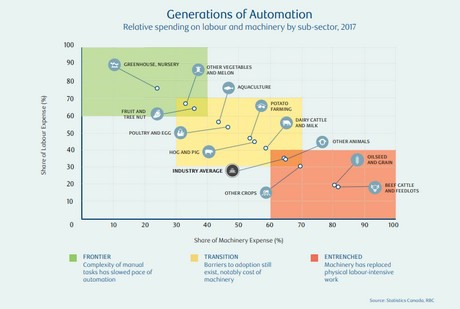“Canada could gain $11 billion in annual GDP by 2030 by closing the agricultural labour gap and accelerating investment in technology,” says a new report by the Royal Bank of Canada. It says that investment into and adoption of new technologies in the sector is a necessity to offset the labour crisis that farmers and growers face in the sector.
Tooling robots to pluck berries
The report does say that some horticultural facilities use technology. “In the Okanagan Valley, horticulturalists are working with drones and earth sensors to better program their irrigation systems. In the greenhouses of Ontario, mechanics are tooling robots to pluck berries, while people are being redeployed to optimize growing conditions with market conditions.”
Though when it comes to horticulture, the adoption is going quite slow, especially compared to some more precise open field endeavors. “In contrast to precision-agriculture, the greenhouses and fruit farms of southern Ontario, continue to rely on low-skilled, physical human labour.”
One of the main reasons for this is the ease of implementation of technology. “Some farm production, such as cow milking, is simply easier to automate. Fruit picking, which requires judgment and dexterity, has been more resistant.” Another major barrier to increased automation is capital. “Advanced technologies may have the potential to cut operating costs in the long run, but they are expensive to acquire and implement.”

According to the report, if the horticultural sector does shift their focus more towards automation there will be a change in the amount of people employed and the skills required for the work. “With machines that can pick and pack produce, the new roles will require workers to interpret data not ripeness.”
But there are also opportunities for the sector. Canadian farmers can look to the Dutch, United States, and Israeli horticultural sector for some inspiration on how to automate their operations.
The Dutch, United States, and Israeli technological developments are also related to their focus on education and research in the sector. All of these countries focus a lot on technological innovations for the sector.
Overall, the report offers a lot of potential solutions to the increasing problem of labour that the Canadian agricultural field is facing. The main takeaway from the report for the horticultural sector is a need for increased focus on automation in the sector, which means investing in new technologies.
